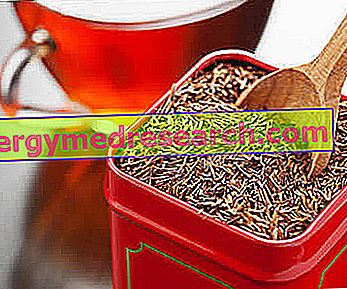What is Rooibos
The rooibos is a drink obtained by infusion of the dried leaves of Aspalathus linearis, a South African shrub plant, belonging to the Fabaceae family and typical of the Cederberg region.

The modest content of tannins and the absence of caffeine (theine) give the rooibos a pleasant taste, slightly sweet and in any case less bitter than green tea and black tea. This characteristic, together with the discrete antioxidant content, is decreeing an important commercial success of the beverage, whose diffusion is significantly increasing also in Italy.
Differences between the VARIOUS TYPES of Tea
| Tender | Green tea | White Tea | Red Rooibos | |
| Flavor | Strongly bitter | Bitter | Delicate | sweetish |
| Tannin content | High | Very high | Moderate | Moderate |
| Caffeine content | High | Moderate | Bass | Absent |
| Characterizing Active Principles | Teina - Catechine - Tannins | Catechins - Tannins | Catechins | Aspalanthin and structural analogues |
| Antioxidant power | High | Very high | Very high | Moderate-High |
Characterizing active ingredients
The most important active ingredient for the health- giving applications of rooibos appears to be aspalantin, a type of flavonoid in the glucosidic form.
Its concentrations are higher in unfermented leaves (about 10%), while they decrease significantly with fermentative processes (0.10%).
In addition to aspalantin, other active ingredients of health interest are notophagine and aspalalin (both structurally related to aspalantin ), several other flavonoids (rutin, isoquercitin, vitexin, isovitexin) and phenolic acids (caffeic acid, ferulic acid).
Indications
Why do we use rooibos? What is it for?

Recently, in the local bars the practice of serving the concentrated rooibos has spread, in the quantities and in the ways that recall those of the espresso coffee.
In the West, the use of Camelia sinensis instead of tea is also favored by the alleged health aspects attributed to the regular consumption of rooibos.
Benefits and Property
What benefits has the rooibos shown during the studies?
Like many other herbal preparations used in folk medicine, the therapeutic uses and alleged health benefits deriving from the consumption of African red tea are based above all on folkloristic aspects, rather than on real scientific evidence.
The marketing campaigns, for their part, magnify the antioxidant virtues and the beneficial effect in case of insomnia, heart disease, hypertension, agitation, asthma, dermatitis, headache, liver intoxication and mild depression.
Many of these properties have emerged from in vitro studies, while in vivo studies - which are numerically meager - have significantly reduced their true extent. This appears to be due to the poor bioavailability of the active ingredients contained in the drink.
Among the various effects studied, the evidence to support a beneficial effect for patients with high cardiovascular risk, in which the intake of rooibos could produce some benefit in normalizing blood lipids (cholesterol and triglyceride reduction, if high) appears to be greater. and glycemic values (if elevated, naturally assuming the sugar-free rooibos), and in preventing lipid peroxidation (useful against atherosclerosis).
Finally, we point out that the antioxidant activity of African red tea appears to be significantly inferior to the studies exhibited by green tea, even when the latter is taken at lower doses.
Doses and method of use
How to use the rooibos
After harvesting, the needle-like red leaves and parts of the stems can be bruised and fermented before the next drying phase, or dried directly without fermenting them.
The infusion obtained from the unfermented drug maintains a greenish color and is therefore known as green rooibos .
During fermentation, the color of the drug changes from green to red, due to the oxidation of polyphenols; consequently, the infusion of the fermented drug gives rise to a red-brownish drink, known as red rooibos .

The preparation of the drink is like tea, using an infuser or the appropriate sachets.
Although there is no recommended standard intake level, the daily intake of the infusion obtained with 750-3000 mg of dried leaves, preferably distributed during the day, could be optimal.
Side effects
Currently there are no significant side effects attributable to the use of rooibos.
Contraindications
When should the rooibos not be used?
Consumption of rooibos is contraindicated in patients with established hypersensitivity to the active ingredient.
Pharmacological Interactions
Which drugs or foods can modify the effect of the rooibos?
Consumption of red rooibos in conjunction with iron supplementation could slightly reduce intestinal mineral absorption. This undesired effect, due to the modest tannin content, appears to be significantly lower than that attributed to black tea.
The consumption of rooibos would also seem to increase the activity of the cytochrome CYP3A, reducing the metabolic activity of the drugs metabolised by this cytochrome, such as midazolam.



